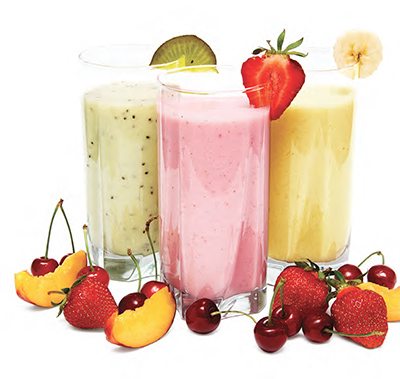
Lay out five to 10 servings of fruits and vegetables on the kitchen counter and the idea of scoffing them down looks daunting. Blend them into an ice-cold smoothie, however, and it becomes very doable and delicious.
Smoothies give you some serious nutritional bang for the buck. A pureed power punch, smoothies help you hit your daily nutrition quotas and so much more. But be weary because not all smoothies are created equal. If not carefully selected, you might find yourself drinking a milkshake disguised as a smoothie. Read on to get smooth about smoothies.
Smoothie Goodness
 Smoothies are incredibly versatile. You can create your very own personalized concoction using whatever fruits, vegetables, dairy and even seeds you like. The sky is the limit. These pureed powerhouses help you get your daily dose of antioxidants, protein, fiber and vitamins in an easy-to-down and flavourful way.
Smoothies are incredibly versatile. You can create your very own personalized concoction using whatever fruits, vegetables, dairy and even seeds you like. The sky is the limit. These pureed powerhouses help you get your daily dose of antioxidants, protein, fiber and vitamins in an easy-to-down and flavourful way.
Fruit smoothies can help you reach the recommended intake of fiber. A serving of fruit typically contains two to four grams of fiber with berries, pears and apples having the highest concentration with five to seven grams per serving. What’s more is that fruit’s soluble fiber also helps slow down digestion and may help control blood sugar and lower cholesterol.
Creating your own smoothie means you get to choose a base of your liking. You can use water, fruit juice, dairy (milk or yogurt) or a dairy alternative (soy, rice or almond milk) to add bulk. Water, low-fat dairy or dairy alternatives cut down the number of calories. For an extra kick and bulk, consider adding chia seeds or flax seeds — both of these seeds take your smoothie from food to superfood.
Your best bet for a healthy smoothie is to keep it simple. For example, use just four ingredients: two fruits or a fruit and vegetable, non-fat dairy, and a source of protein. Smoothies that include non-fat/low-fat dairy or dairy alternatives will likely give your smoothie a protein boost not to mention nutrients like vitamin D, B-12 and calcium.
If smoothies are your meal replacement, look to have at least five grams of fiber and five grams of protein as part of the blend. This ensures you are getting the macronutrients you would in a meal and helps stave off hunger for a bit longer. If your smoothie is a snack, go for a small size and keep it under 300 calories.
Beware the Blended Mess
In theory, smoothies seem like the perfect food. Fruit, veggies, a splash of milk or juice all served up blended and chilled. Sounds pretty good. What could be so bad about that? Unhealthy ingredients can turn a smoothie into a blended mess. Sugar content can transform a perfectly good smoothie to liquid candy. This can happen if you use sweetened fruit juice, ice cream or frozen yogurt, drizzles of honey, tons of bananas or just plain old sugar. And too much fat can take you from smoothie-land to milkshake-land real quick. It’s fine if that’s where you’re headed but if you are on the healthy train then steer away from including ice cream, full-fat dairy, whipped cream, peanut butter or chocolate. Otherwise, you could end up with a 600-plus calorie drink.
Store-bought or restaurant smoothies often contain added sugar, increasing the calories without increasing the nutrients. Sugar content for these can be between 20 and 35 grams per serving (including naturally occurring fruit sugars). Making your own smoothie allows you to control added sugars. Another pitfall is easily consuming too many calories by drinking very large smoothies, especially if you’re getting your smoothie from a smoothie shop. Check the calorie content for each size before ordering. Limit the amount of high-calorie addins when making smoothies at home to keep the calorie content under control.
SmoothieFix
Freeze It: Freezing fruit is a no-brainer. Frozen fruit make your smoothies thick and frosty. Peeled whole or sliced bananas, berries and cherries, sliced fruits (peaches, plums, nectarines and apricots) and many other fruits freeze well and blend nicely in a regular blender as long as they’re cut small and you’ve added enough liquid. High-speed blenders can handle large pieces of frozen fruit without much trouble as long as there's some liquid to get them started.
Protein Power: Adding protein to your smoothie not only gives you essential amino acid building blocks but also helps thicken. Adding whey protein to smoothies is an easy way to ramp up protein content but you can also use Greek yogurt, milk and even cottage cheese. Dairy alternatives like soy milk or almond milk give a protein boost too. And tofu is one of the best pops of protein — it adds protein and takes on the flavour of all the ingredients combined.
Texturize: Take a sweet smoothie to creamy and dreamy with a tablespoon or two of peanut, almond or another nut or seed butter. Avocado is also a great way to add some creaminess — definitely the choice for green smoothies. Greek yogurt not only adds protein but texture too. A few tablespoons of cooked oatmeal is a great trick as well.
In a dish dilemma? Email me @ [email protected]
Neera Chaudhary MHSc PhD (c) RD is a registered dietitian, foodie, culinary goddess and all-around fabulous girl in the kitchen. www.dietitian.ca
PUBLISHED IN THE HEALTH & WELLNESS ISSUE/SUMMER 2014
Neera Chaudhary
Author
Neera Chaudhary is always on the lookout for the veritable wellness ingredients to feed your mind, body and soul because she knows beauty starts from the inside out. Neera helps to make sense of the science behind the plethora of prescriptions out there by sharing the essential elements for a heal...

















































































































